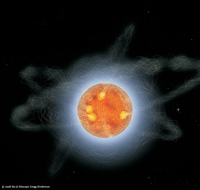New model promises to unify view of magnetars
14 November 2008
A recent model of the emission from ultra-magnetized neutron stars (magnetars) shows great promise in offering a unified view of the high energy emission from these objects. This is reported by Nanda Rea and colleagues in a recent issue of the Astrophysical Journal. The results are based on the systematic analysis of data collected with XMM-Newton and INTEGRAL.
 |
|
Artist's impression of a magnetar. Credit: 2008 Sky and Telescope, Gregg Dinderman |
Magnetar is the name given to two types of sources: anomalous X-ray pulsars (AXP), and soft gamma repeaters (SGR). First discovered in the X-ray band, these sources are believed to contain an ultra magnetized neutron star, that is a neutron star with a magnetic field of the order of 1014-1015G.
Evidence for such strong magnetic fields is so far indirect, and it is based on the classical dipole spin-down relation for rotating neutron stars, as well as on the interpretation of the X-ray burst phenomenology that has been observed.
Nature's laboratory provides insight to exotic phenomena
Such a strong magnetic field is remarkable because it exceeds the critical magnetic field (~4.4x1013G) at which the cyclotron energy equals the electron rest mass. Under these conditions, impossible to create in the laboratory, exotic quantum electrodynamic effects such as photon splitting and single electron pair production can take place. Establishing that such conditions do exist in the universe, coupled with continued sensitive observations of these sources, can help us understand some of these phenomena.
Neutron stars power different classes of astronomical sources, usually through their spin-down power, or the accretion of matter. What makes magnetars stand out is that their X-ray luminosity exceeds their spin-down luminosity by two orders of magnitude. Clearly their energetics cannot be explained in terms of rotational energy losses alone. Scientists have identified the large magnetic field as the source of the emission.
More sensitive observations are the key to improved models
Only a score of magnetars are known. As often happens in astronomy when a new class of source is discovered, a sort of source taxonomy is part of the early comprehension efforts, whereby the new sources are classified based on some of their basic phenomenological properties. Sub-classes may be created, and simple models developed to provide a first order interpretation of the physical conditions at play. When sensitive observations become available, the improved statistics allow scientists to carry out a more sophisticated analysis, and to hone the models.
This is what Rea and colleagues have done, by systematically applying the Resonant Cyclotron Scattering model to all deep (>105 counts) XMM-Newton observations of magnetars. Where possible, they also called on the corresponding INTEGRAL observations, to help them gain insights into the relation between the magnetars’ emission below and above 10keV.
In the RCS model the thermal photons emitted by the surface of the neutron star propagate outwards in a region with a strong, but radially decreasing, magnetic field, and filled with an electron plasma. Under the right conditions, the thermal photons can be boosted up to X-ray energies by multiple resonant cyclotron scattering events.
Rea and coworkers find that this model fits well all of the observed magnetars, and this allows the authors to start drawing conclusions about the physical conditions in these objects that are also consistent with the observational details.
The authors stress that the model is still a simplification of the actual physics, and promise more work on the subject. But, with as many free parameters as the usually employed phenomenological model (black-body plus power law component), the RCS promises to give more insights into the inner mechanisms of these exotic objects.
Reference PublicationRea, N., et al., "Resonant Cyclotron Scattering in Magnetars' Emission", Astrophysical Journal, 686:1245-1260, 2008, DOI:10.1086/591264
Web story author:
Giuseppe Vacanti
